
The Visconti of Milan are a noble Italian family. They rose to power in Milan during the Middle Ages where they ruled from 1277 to 1447, initially as Lords then as Dukes, and several collateral branches still exist. The effective founder of the Visconti Lordship of Milan was the Archbishop Ottone, who wrested control of the city from the rival Della Torre family in 1277.

Muzio Attendolo Sforza, was an Italian condottiero. Founder of the Sforza dynasty, he led a Bolognese-Florentine army at the Battle of Casalecchio.
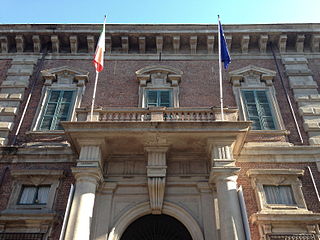
The Accademia di Belle Arti di Brera, also known as the Accademia di Brera or Brera Academy, is a state-run tertiary public academy of fine arts in Milan, Italy. It shares its history, and its main building, with the Pinacoteca di Brera, Milan's main public museum for art. In 2010 an agreement was signed to move the accademia to a former military barracks, the Caserma Magenta in via Mascheroni. In 2018 it was announced that Caserma Magenta was no longer a viable option, with the former railway yard in Via Farini now under consideration as a potential venue for the campus extension.

Alfonso Michele Litta was an Italian nobleman who was a Cardinal and Archbishop of Milan from 1652 to 1679.

Gabriele Sforza, was a member of the Augustinian Order who served as Archbishop of Milan from 1445 to his death in 1457.

Carlo III Gaetano Stampa (1667–1742) was an Italian cardinal and Archbishop of Milan from 1737 to 1742.

Cherubino Cornienti was an Italian painter, active in a Romantic style mainly in Northern Italy.

Ferrante d'Este was a Ferrarese nobleman and condottiero. He was the son of Ercole I d'Este and Eleonora d'Aragona - he was named after his mother's father Ferdinand I of Naples. His five siblings were Alfonso I d'Este, cardinal Ippolito d'Este, Isabella d'Este, wife of Francesco II Gonzaga, Beatrice d'Este, and Sigismondo d'Este. His two illegitimate half-siblings were Giulio and Lucrezia d'Este.
Alfonsino d'Este was a Ferrarese nobleman, heir apparent to Montecchio Emilia.
Ercole Bevilacqua was an Italian nobleman, soldier and statesman.
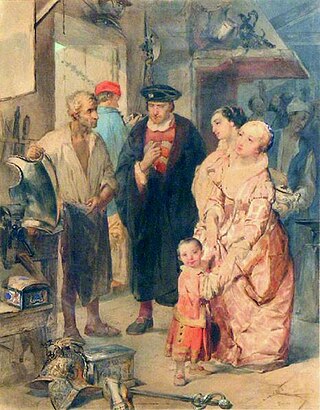
Alessandro Durini, 6th Count of Monza was an Italian nobleman and painter, primarily in watercolors, depicting historical and genre subjects.
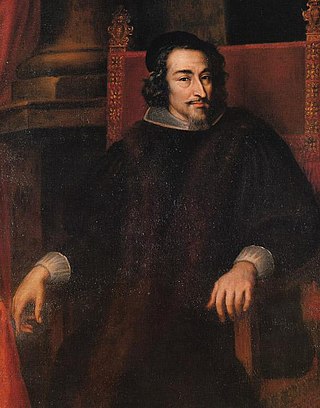
Bartolomeo III Arese count of Castel Lambro born in Milan on 23 October 1590 and died in the same city on 23 September 1674 was an Italian nobleman, politician, and prominent member of the House of Arese.
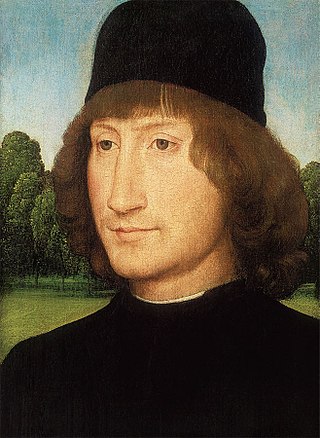
Sforza Secondo Sforza was an Italian condottiero.
Adalberto the Margrave, also known as "il Margravio" or "Adalberto III" was an Italian nobleman tied with the Obertenghi family and a well-known ancestor to the Este, Pallavicini and Malaspina family.

The Visconti Castle of Crenna is a castle of mediaeval origin located in Crenna, frazione of Gallarate, Lombardy, Northern Italy. It is linked to the fame of Lodrisio Visconti, who raised against and then reconciled with the members of the family of his cousin Matteo Visconti, Lord of Milan. In the 14th century, the castle underwent expansion and destruction according to the alternative fortunes of Lodrisio.

Margherita Malatesta of the House of Malatesta was the wife of Francesco I Gonzaga of the powerful House of Gonzaga, the ruler of Mantua in the north of the Italian peninsula, whom she married in 1393. She acted as regent during the absence of her spouse in 1398-1399.
The Stampa are a well-known family of old Italian nobility that rose to prominence in the 15th century. They were Grandees of Spain, members the Order of the Golden Fleece and owned many estates throughout the Italian Peninsula, including a Castle in Soncino, a Palace in Milan, and countless others in Muggiò, Melzo, Gorgonzola, Rivolta d'Adda, Ferentino and Rome. They are related to some of the most important Italian noble houses, such as the Doria, Sforza, Gonzaga, Borromeo and Visconti.

Massimiliano Stampa was an Italian nobleman and politician, 1st Marquess of Soncino.

The Visconti Castle of Jerago is a castle of Middle Age origin located in Jerago, Lombardy, Northern Italy. Having been a property of members of the Visconti house between the 13th and 18th centuries, it retains still today their memory in its name.
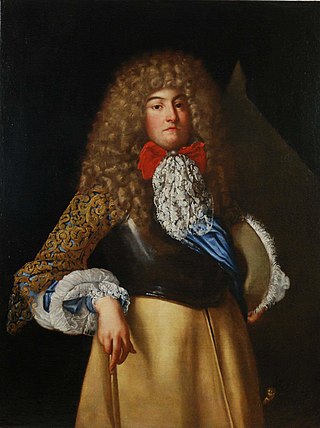
Alessandro II Pico della Mirandola was an Italian nobleman, soldier and patron of the arts, second Duke of Mirandola and third Marquis of Concordia from 1637 until his death.






















